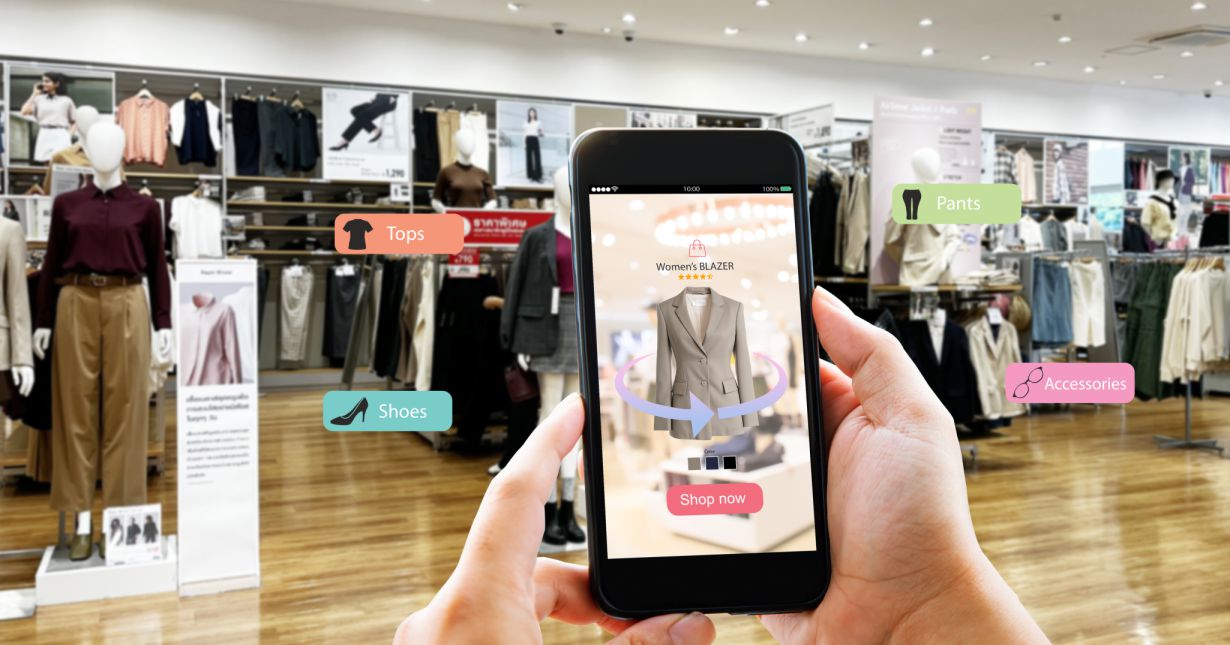People’s ways of shopping have changed significantly over the past few years. Customers now expect a seamless experience whether they are browsing online pr walking in a store. This is where Phygital solutions play a crucial role.
Phygital is the combination of physical and digital, and it merges in-store experiences with online tools to create a more engaging and efficient shopping journey. Phygital majorly includes solutions such as visual commerce, virtual try-on, digital showroom, and more.
All these solutions work together to improve customer interaction, boosting customer experience and improving product discovery. With the rapid advancement in technology, the phygital trends are evolving and becoming essential for both retail businesses and eCommerce stores.
This blog will guide you through the top phygital trends that are reforming retail and eCommerce. Each of these trends offers practical benefits that will help your business scale, create deeper customer connections, and boost sales.
So, if you are wondering how phygital will help you in scaling your business, this blog will provide valuable insights. And if you are seeking help for phygital implementation in your business, we will also help with that.


Customer Experience
Customer experience is a critical driver in today’s eCommerce world. Phygital solutions make it easier for businesses to create a unified and responsive interaction between customers and products.
Know how phygital solution can power your retail business.
From personalized recommendations to interactive customer service, every touchpoint plays a crucial role in making customers feel valued. Phygital tools allow you to gather customer feedback and respond instantly, creating a sense of reliability and trust.
Example: Sephora’s mobile app not only helps customers book consultations but also provides beauty tips, product tutorials, and reviews based on individual preferences. This helps in increasing loyalty as customers keep coming back.
By continuously improving customer experience by applying useful technology, your business can reduce churn rate and increase customer satisfaction. This is why more retail businesses are integrating these solutions into their operations.
Virtual Try-On
Virtual try-on technology goes beyond novelty; it solves a real problem. Online shoppers often hesitate because they cannot physically see or feel products. Virtual try-on eliminates this barrier, especially for categories like apparel, eyewear, footwear, and cosmetics.
Example: L’Oréal’s virtual try-on experience allows users to test makeup products in real-time using augmented reality. This boosts conversion rates by helping customers visualize how the product will look before purchasing.
Adding virtual try-on to an eCommerce store increases customer confidence, reduces return rates, and improves overall shopping satisfaction. If you want to improve customer experience, then VTO is a must.


Visual Commerce
Retail and eCommerce stores are incomplete without visual commerce as it leverages images, videos, and interactive content to make product discovery more engaging. High-quality visuals help attract attention and communicate the brand message effectively. It helps customers understand product features without the need for in-depth text descriptions.
Example: IKEA’s AR app lets customers virtually place furniture in their homes, providing a sense of scale, color, and texture. This hands-on approach helps customers make informed decisions.
Visual commerce bridges the gap between online and in-person shopping by providing the kind of detail customers expect when they browse in a physical store. It’s one of the strongest phygital trends helping retailers stand out.
3D Development
3D models are increasingly being used to enhance product visualization. Customers can view products from every angle, zoom in on details, and see features that photos or static descriptions cannot capture.
Example: Nike’s online store offers detailed 3D views of shoes. Customers can examine stitching, sole patterns, and textures. This helps them feel more connected to the product before making a purchase.
For retail business owners, this means fewer product returns and higher confidence in customer decisions. 3D development is quickly becoming a standard expectation rather than an added feature.


Digital Showroom
Digital showrooms replicate the in-store shopping experience online. This allows customers to explore collections, view pricing, read reviews, and consult with experts without ever stepping inside a store.
Example: Toyota’s digital showroom gives users access to view, configure, and compare features of different models. Further, the booking options make the buying process smoother.
A retail business that uses digital showrooms can extend its reach beyond geographic boundaries, making it easier to attract and retain customers while providing all the conveniences of a modern shopping experience.
Omnichannel Retail
Omnichannel retail focuses on offering a smooth experience across all customer touchpoints. It integrates mobile apps, websites, social media, customer support, and physical stores into one cohesive journey.
Example: Nordstrom’s omnichannel strategy allows customers to shop online, reserve items for in-store pickup, and interact with sales associates via chat. This creates continuity and flexibility.
Studying 3D models can boost manufacturing industry production.
For eCommerce stores, an omnichannel approach helps reduce friction between different platforms. It encourages customers to engage across multiple channels. Also, it increases customer retention by providing options that fit their preferences.


Video Commerce
Video commerce improves product storytelling by offering visual demonstrations, tutorials, and customer reviews. Videos also help answer questions customers may not even realize they have, making it easier to finalize a purchase.
Example: Glossier’s how-to videos show the application process for beauty products. These engaging videos answer customer questions and highlight product benefits, driving both trust and sales.
Video content is especially effective for new product launches, as it helps build excitement and familiarity with the brand. It is a key phygital trend that shapes how products are marketed today.
Understand the benefits and application of virtual shoe try-on for footwear.
Social Commerce
Social commerce blends shopping with social interactions. This allows customers to buy products directly from platforms like Instagram, Facebook, or TikTok. Shoppable ads and video content make it easier for brands to reach target audiences.
Example: Instagram’s shopping feature lets users explore products featured in posts and reels, with direct links to checkout options.
With social commerce, businesses can tap into customer networks and build communities around their products. This trend is essential for growing an online presence and capturing new customer segments.
Study why virtual try-on is a website traffic booster for your business.


Hyper-Personalization
Hyper-personalization goes beyond recommending products based on past purchases. It uses behavioral data, location, and real-time engagement to craft unique offers that feel more relevant and appealing.
Example: Stitch Fix’s service uses customer feedback and style preferences to suggest outfits, helping users discover products that suit their taste.
By offering experiences that feel curated specifically for each shopper, phygital solutions boost satisfaction and encourage repeat purchases. Retailers that embrace hyper-personalization can better meet customer expectations and build long-term loyalty.
Know why virtual showrooms are essential for retail businesses.
AI-Powered Recommendation
AI-powered recommendation systems use algorithms to predict what products customers are most likely to buy. This helps businesses cross-sell complementary products or suggest upgrades at the right moment.
Example: Amazon’s recommendation engine analyzes buying behavior, search history, and customer reviews to display relevant products, significantly increasing conversion rates.
AI-driven recommendations not only improve customer experience but also improve revenue streams by guiding shoppers toward products they are more likely to purchase.
Learn why you need virtual try-on for your jewelry eCommerce website.


Advanced Chatbots
Advanced chatbots powered by AI and natural language processing help customers navigate shopping experiences by answering questions, recommending products, and resolving issues instantly.
Example: H&M’s chatbot assists users in finding styles based on trends, availability, and customer preferences while guiding them through the checkout process.
With immediate responses and personalized assistance, chatbots create a supportive environment that encourages customers to complete purchases and return for future interactions.
Frictionless Checkout
Frictionless checkout simplifies the final steps of the shopping journey. Features like one-click payment, saved addresses, and digital wallets reduce hesitation and prevent cart abandonment.
Example: Apple Pay integrates across multiple platforms, allowing users to complete purchases in seconds without repeatedly entering payment information.
For retail business owners, this trend helps maintain momentum throughout the customer journey and minimizes lost sales opportunities.
Discover the development cost of a virtual store tour.


QR Codes
QR codes are a simple yet powerful tool to connect physical spaces with digital content. They provide instant access to product details, reviews, or promotions.
Example: McDonald’s uses QR codes in their outlets for easy ordering, online payment, and order updates, creating a frictionless experience.
QR codes are particularly helpful in in-store environments where customers want quick access to information without waiting for assistance.
These phygital trends are reshaping how businesses approach customer engagement, product discovery, and checkout. Whether you operate a small boutique or a global eCommerce store, integrating these technologies helps you stay competitive and meet modern shoppers’ expectations.
Study the top virtual showrooms providing companies.
Conclusion
The phygital trends shaping retail and eCommerce are no longer optional. Businesses that adapt to these changes will gain a competitive edge by improving customer experience, increasing engagement, and driving sales.
These technologies help businesses provide seamless shopping journeys, create personalized interactions, and reduce barriers to purchase. For entrepreneurs and business owners, embracing phygital solutions is key to growth.
If you are exploring how digital helps in scaling business, now is the time to invest in these innovations. And if you are unsure where to start, some experts can guide you through the process; needing help with phygital implementation is a question you should not hesitate to ask.
The future of shopping is here. By leveraging phygital trends, your retail business and eCommerce store can thrive in an increasingly connected world.
